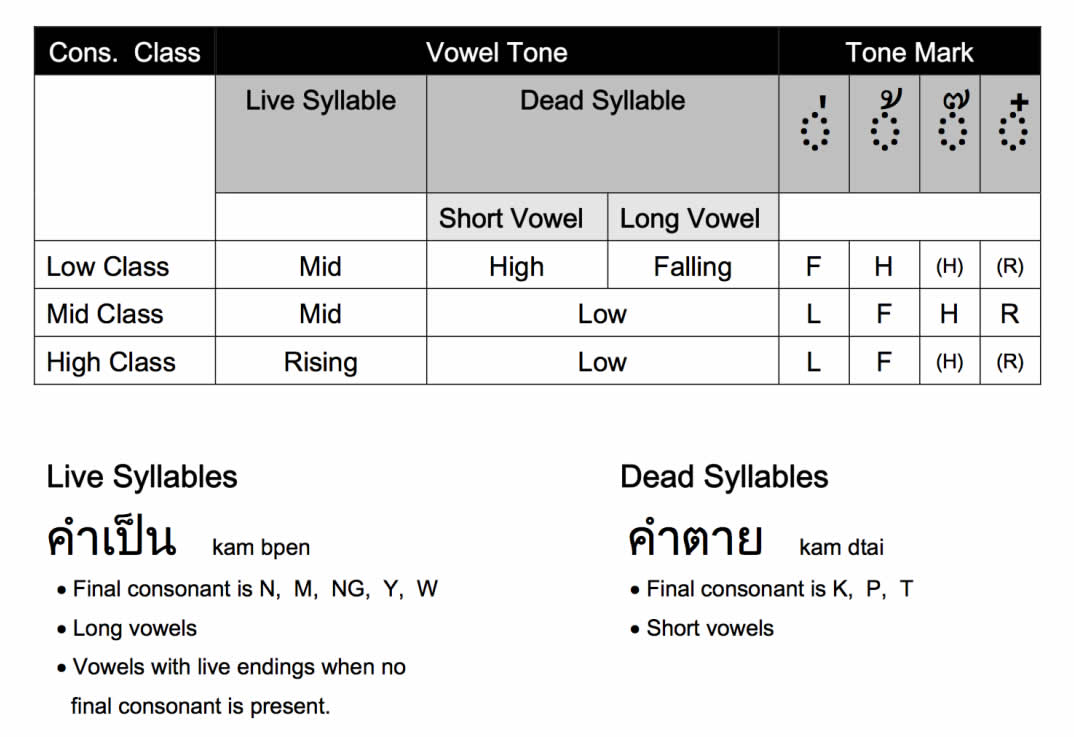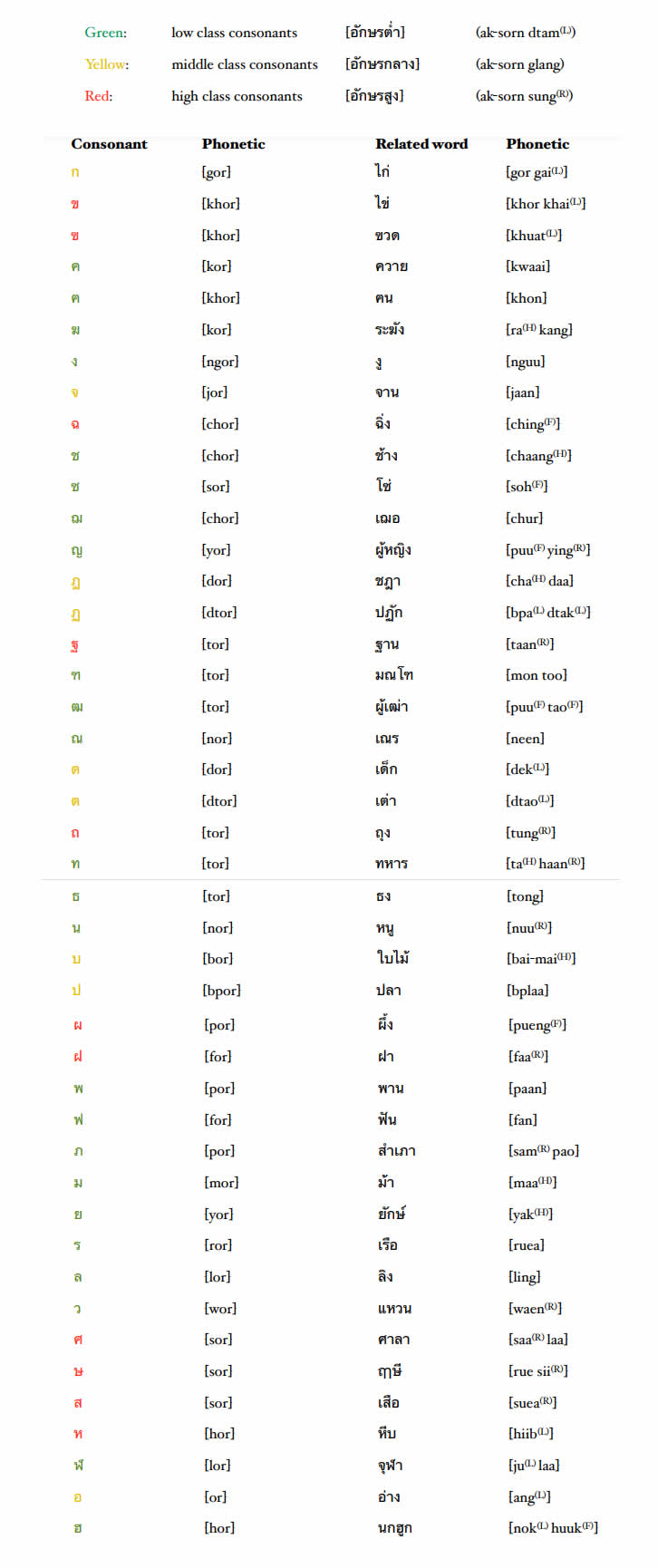Language/Thai/Pronunciation/LOW,-MIDDLE-AND-HIGH-CLASS-CONSONANTS
5 tones
You need to know what class the respective consonant fits in, in order to know how to pronounce the words correctly. There are 5 tones in the Thai language, but only 4 are marked, and they got the following signs (the mark on top of อ consonant):
Which tones above different consonants
There are specific rules on which tones you can place above the different consonants. This can cause great frustration, so let me give you a few tips on how to learn the system:
- Any of the four tone marks can be put on-top middle class consonants.
- Only อ [mai ek] and อ [maito] can be on top low class consonants.
- Only อ [mai ek] and อ [maito] can be on top high class consonants.
Exceptions
These three steps should be easy. Now, here comes the tricky part:
- When อ [mai ek] is put on-top low class consonants it will make a อ [mai to] sound, e.g. ไม [mai] meaning “no”. ม [mor maa] is a low class consonant, but with a อ [mai ek] on top, a falling tone อ [maito] comes out.
- When อ [mai to] is put on-top low class consonants it will make a อ [mai dtrii] sound, e.g. มา [maa] meaning “horse”. ม [mor maa] is a low class consonant, but with a อ [maito] on top, a high tone อ [mai dtrii] comes out.
- When อ [mai ek] and อ [mai to] are put on-top high class consonants it makes the sound that it is supposed to make. A high class consonant with no tone symbol will by nature make a อ [jat dtawaa] sound, e.g. เสอ [suea] (tiger).
- When either four of the tones are put on-top middle class consonants it makes the sound that it is supposed to make. With nothing on top, the tone is a middle tone.
- When referring to these sounds, they are called: เสยง [siang] (sound) and then followed by either เอก [ek] โท [to] ตร [dtrii] or วตวา [jat dtawaa], e.g. เสยงเอก [siang -ek].
- NOTE: there are different other rules that mix up the rules I just stated above, it’s called คเปนคตาย [kam bpen kam dtaai] (live or death syllable).
Consonant Class, Vowel Tone & Tone Mark
Please see the following sheet:
Example
Let me give you an example:
ชาต [chaat] (nationality) is ending with a T sound. Then we know that it is a dead syllable. Then we can see from the sheet, that with a short vowel it will be a high tone, but with a long vowel it will be falling. The vowel า is a long A sound which makes the pronunciation sound of ชาต [chaat] falling. Get the picture? ชาต [chaat] starts with a low class consonant and have no tone mark, then it should be a middle tone, but due to it being a dead syllable the tone changes. Don’t pay too much attention to this for a start, soon you will remember the sound of the word, and this sheet won’t be to much use. And for the record, you will have problems with เสยงตร [siang(R) dtrii] for sure.
For these exotic rules we can only thank the founders of the Thai language.
Difficulty with pronouncing บ / ป and ด / ต
I have had so much trouble with these four consonants, just as any foreigner learning Thai. The sound are so similar to our ears, yet so different in Thai ears. บ [bor bai mai] is a clean B sound where ป [bpor bplaa] is more of a harder BP sound. ด [dor dek] is a softer D sound while ต [dtor dtao] sticks the tongue out more to make a harder DT sound. This point is difficult to explain, but it is crucial. You need to face this difficulty your self in order to learn it, but I recommend you doing it straight from the start. I waited one year before paying attention to it. Fix this and you are on the right path to sound like a Thai.
ห
The consonant ห [hor hiip] is a high class consonant that got a special skill; being put in front of a low class consonant, the word will get a เสยงวตวา [siang jat dta waa] (rising tone) e.g. หญง [ying] (girl). So, the ห [hor hiip] makes the word a “high class word”. According to that, if a high class word is a คตาย [kam dtaai] (dead syllable) it is pronounced with a เสยงเอก [siang ek] (low tone), e.g. เหลก [lek] (metal) or หนก [nak] (heavy). Don’t pay too much attention to the live or dead syllable, because you will learn how the different words are spelled and you will remember what tone is linked to it automatically.
ทร consonant cluster
This consonant cluster should make a [tor ror] sound, but it makes it to an ซ [sor] sound instead. why? I haven’t got the slightest clue, but just remember it. E.g. ทราบ [saab] (formal word of to know). Try to run this through the live/dead syllable: The words ends with a b/p sound = makes it a dead syllable. ซ [sor soh] is a low class consonant. The long A vowel (า) tells us that it should be pronounced with a falling tone.
รร consonant cluster
This cluster turns into an AM sound (อม,อ). Forget the [ror ruea] sound and just replace it. Here is a few examples: ธรรมดา [tam ma daa] (normal, ordinary, common), ธรรมชาต [tam ma chaat] (nature), กรรม [gam] (karma), กรรมการ [gam ma gaan] (judge).
Consonants at the end of a word that creates a diferent sound
There are some consonants that doesn’t make the sound you think they will when being the last consonant in the word. Here is a complete list of those:
- ร [ror ruea] at the end of a word need to be pronounced as: น [nor nuu] e.g. กรรมการ [gam ma gaan] (judge)
- ล [lor ling] at the end of a word need to be pronounced as: น [nor nuu] e.g. นตาล [naam dtaan] (sugar)
- จ [jor jaan] at the end of a word need to be pronounced as: ท [tor ta haan] e.g. อนาจ [am naat] (power, authority)
- ช [chor chaang] at the end of a word need to be pronounced as: ท [tor ta haan] e.g. ออนนช [On Nut] (name of area in Bangkok)
- ส [sor suea] at the end of a word need to be pronounced as: 24 ท [tor ta haan] e.g. รส [rot] (flavor)
- ษ [sor rue-sii] at the end of a word need to be pronounced as: ท [tor ta haan] e.g. การเกษตร [gaan gaset] (agriculture), NB. the ต and ร are silent in this word.
- ศ [sor saa laa] at the end of a word need to be pronounced as: ท [tor ta haan] e.g. ประเทศ [bprateet] (country)
Table: Class for each Consonant




